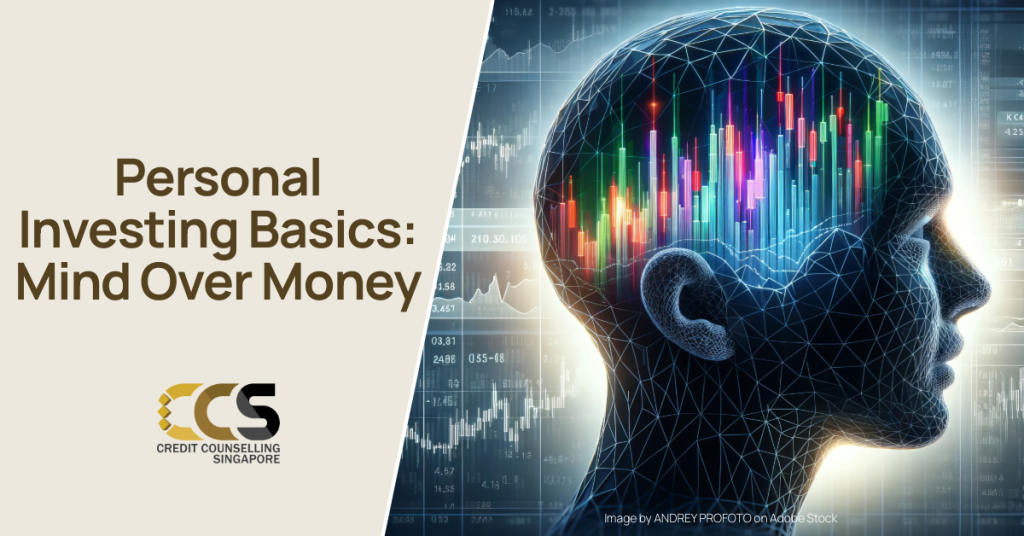Personal Investing Basics: Mind Over Money

In this article, we'll explore how emotions impact personal investing, often leading us to make irrational decisions driven by greed and fear. We'll also dive into the cognitive and emotional biases that influence our investment choices, helping you understand and mitigate these biases for better investment outcomes.
The Impact of Emotions on Personal Investing
Many individuals who have attended investment courses learn the basics of successful investing: diversify to reduce risk, practice dollar-cost averaging, buy and hold rather than trade frequently, and always do your homework first. Yet, when it comes to taking action, emotions often override these principles.
Many investors buy high in the hope of selling higher, hold onto loss-making positions for years, and make decisions based on tips or rumours rather than thorough research. The two main investing emotions, greed and fear, frequently lead to abandoning both lessons learned and logic.
In the past 20 years, behavioural finance has gained prominence, helping investors understand their decision-making processes. This field acknowledges that people do not always behave rationally, especially when faced with complex decisions. Information overload in everyday life often leads us to simplify choices and settle for a "good enough" solution rather than striving for the optimal one.
Studies have shown that when faced with complex decisions, people struggle to come up with rational solutions. Regularly encountering information overload worsens the problem, causing us to simplify choices and settle for satisfactory solutions rather than the best ones.

Photo Credit: Vitalii Vodolazskyi from Adobe Stock
How Biases Influence Investment Decisions
Psychological biases, which can be broadly classified as cognitive and emotional, significantly impact investment decisions. People generally seek to avoid pain and pursue pleasure, often refusing to acknowledge mistakes to maintain a positive self-image.
Cognitive Biases
1. Cognitive Dissonance: This occurs when new information conflicts with existing beliefs, causing mental discomfort. For example, despite overwhelming evidence linking smoking to health issues, smokers might justify their habit by downplaying the risks or believing they are exceptions. As another example, a person who considers themselves environmentally conscious might struggle to reconcile their car's high emissions with their green values. To reduce this discomfort, they might justify their car use by emphasizing its convenience or necessity.
2. Confirmation Bias: Investors seek out information that confirms their existing beliefs and ignore contradictory evidence. This bias can lead to holding onto losing investments by rationalizing that "it's different this time." For instance, if someone believes a particular diet is the best for weight loss, they might only read articles and watch videos that support this view, ignoring any research suggesting other diets might be more effective.
3. Anchoring: The mind fixates on a specific value or "anchor." For instance, if a stock was bought for $1 and rose to $2 before dropping to $1.50, the investor might focus on the $2 mark and feel they have "lost" $0.50, waiting for the stock to return to $2 before selling.
As another example, if a person is shopping for a car and sees one priced at $30,000, they might perceive a $25,000 car as a great deal, even if $25,000 is still above their original budget. The $30,000 price becomes the anchor that influences their perception of value.

Photo Credit: Prostock-studio from Adobe Stock
Emotional Biases
1. Loss Aversion: Investors dread selling underperforming stocks because they can't stomach realising a loss. To understand this bias, think of someone who has bought a concert ticket for $100 and later finds out they can't attend. They might refuse to sell it for $80, even though the $80 is better than getting nothing. The pain of losing $20 outweighs the rational decision to recoup some of the cost.
2. Overconfidence: This is an unwarranted faith in one's abilities and judgments, leading to excessive risk-taking and over-trading. This example may sound familiar to some. A student who did well in Secondary might overestimate their ability to ace ‘A’ Levels without studying as much, leading to poor performance. Their overconfidence in past success blinds them to the need for preparation.
Similarly, overconfident investors might not see the risks clearly and could end up with poorly diversified investment portfolios.
3. Endowment Bias: People value an asset more when they own it than when they don't. You may have felt this way about something of non-tangible value before. For example, you might overvalue an old, worn-out sofa because it has sentimental value or because you’ve owned it for a long time, even though it's not worth much to anyone else. This emotional attachment inflates the perceived value.
Conclusion
Understanding the impact of emotions and biases on investment decisions is essential for success in personal investing. These biases also extend to everyday decisions we make regarding our “everyday” money.
By recognising the role emotions play and identifying cognitive and emotional biases, we can make more informed decisions about our investments as well as personal finances.
Establish the Fundamentals BEFORE Investing
Ensure you have built up a strong financial foundation with adequate insurance and emergency savings before delving into investing. Here are some rules of thumb to consider (we make reference MoneySense Basic Financial Planning Guides here: https://www.moneysense.gov.sg/planning-your-finances-well/): 1. Emergency Savings. Strive to have at least 3 to 6 months’ worth of expenses saved up. 2. Protection with Insurance. Have adequate insurance protection for approximately 9 times your annual income for death and total permanent disability. 3. Protection for Health. For insurance protection again critical illnesses, it is recommended to have about 4 times your annual income as insurance cover. 4. Investing. Once you have prioritised for your emergency and protection needs, you can begin to plan and allocate at least 10% of your take-home pay (this is your income, after deducting CPF contributions) for investments. Remember, an important fundamental principle of investing is to understand the investment product before you invest your money. Additional Resources You can visit MoneySense for “An Introduction to Types of Investments” (link: https://www.moneysense.gov.sg/investments/types-of-investments/) You can also read our article on “Get the Basics Right in Investing” (link: https://ccstest.ccs.org.sg/articles/ccs-230113/). |
| If you enjoy our articles, please follow and like our Facebook page. We post new content every week that you may find useful and engaging. |
Contributed by Credit Counselling Singapore
Published 4 June 2024
